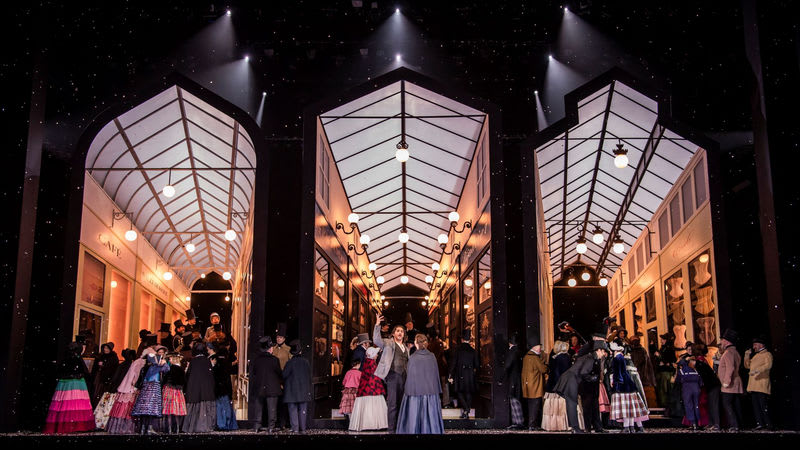What do you do with a girl like Mimi? When in 2017 the Royal Opera wanted to put on La Bohème again, the question was not only how to stage a one of the most familiar works in the repertoire but how to replace what was arguably one of the most familiar productions, John Copley’s having run for over 40 years and 25 revivals.
They turned to Richard Jones, former jazzman turned theatre and opera director, noted according to his Wikipedia entry (quoting director David Pountney) for his controversial, "thrilling, gaudy and wayward" productions.
The result was not as radical as might have been expected, less extravagant in some ways, possibly something of a reaction against the naturalistic atmosphere of what had gone before.
This is not the mythical, tourist image of arty, unconventional, devil-may-care Paris, more a piece of obvious theatricality. These supposed paupers may be merely play-acting, and the three-act play that Charles Castronovo’s Rodolfo feeds into the stove appears to be just seven pages long, an indication of the frivolity with which this nephew of a millionaire regards his muse.
We are reminded that the stage is simply a set as the artist Marcello (Andrzej Filonczyk) paints an imaginary canvas against the invisible fourth wall separating him from the audience, just as the crowds who gather in the following act to buy Parpignol’s toys line up stage-front like the chorus-line in a musical.
And there is no bed in the Bohemians’ stripped-down garret—the dying Mimi must later be laid on a rug. Can they really live there?
The production is a curious mixture in styles, but quite effective for all that. The asperity of the outer acts contrasts with a magnificently staged act 2, which opens onto a vision of three glittering shopping arcades, leading into a decidedly upmarket Café Momus. What more piquant setting could there be for the delightful episode that follows, as a prim couple depart in outrage at the Bohemians' behaviour, before Simona Mihai’s Musetta removes her knickers, and a goggle-eyed waiter joyfully carries off her unlaced shoe?
Snow falls throughout the opera, not just toward the bleak ending, but it is there that Jones pulls off his most daring coup, by having the four frolicking friends drawing comical but semi-pornographic figures all around the attic at the moment Musetta enters with news of Mimi’s impending death.
For this, the second revival of the Jones production, the singing is good throughout and the dramatic interpretation of the vocal line sometimes outstanding, particularly on the part of Sonya Yoncheva as Mimi. Here is a young woman longing for something better in life, ready for someone romantically attractive like Rodolfo. Her pronounced portamento in "Mi chiamono Mimi", silkily sliding from note to note, has a come-and-get-me feel for it, whereas its reprise in the death scene is sung with gentle, cool, heart-rending precision.
Castronovo is a persuasive Rodolfo, seizing his chance to go beyond a little icy-hand warming. His tenor voice has a rich lower register, but can stretch to the higher reaches and hold a fine diminuendo. He and Yoncheva balance perfectly in their duets, but one feels—and this is not necessarily against the script—that his friendship with his fellow Bohemians would be more durable than this love affair.
Filonczyk is an expressive Marcello. His is not a huge voice but its vibrant tone fits well with Rodolfo, then with Mimi in the pivotal act 3, where both actors are for a time on different paths, not listening to each other’s troubles.
There is a cutting clarity to the sound of Mihai, a spirited and convincing Musetta, who is left standing to contemplate the fate of others at the end, a figure chastened by events. Gyula Nagy displays his comic talent as well as a flexible baritone voice as the musician Schaunard.
It is a typical stroke of Puccini genius to interrupt the death scene with the triviality of the philosopher Colline’s farewell to his beloved overcoat, and raise it to the level of pathos. Peter Kellner plays it straight to great effect.
The orchestra under Emmanuel Villaume plays with verve, and transparency, with the recording never allowing it to submerge the singers. The accompanying booklet includes a synopsis, but it would be good to have track timings. The disk, however, includes one of Antonio Pappano’s excellent introductions to the music and interviews with the artists.


